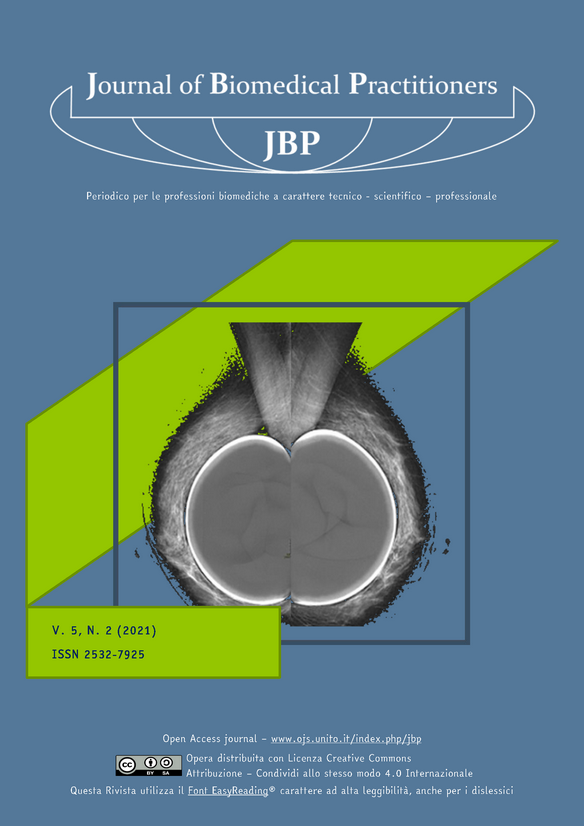Raggiungimento dei crediti formativi nell’era della DaD: il caso del corso di Statistica Medica
Main Article Content
Abstract
La Didattica a Distanza (DaD) è diventata obbligatoria in Italia da marzo 2020, a causa dell’emergenza COVID19.
In questo studio desideravamo quindi analizzare gli effetti della DaD sulle carriere accademiche degli studenti, in particolare sulla loro capacità di superare gli esami. In questo studio pilota, sono state analizzate le performance degli studenti del corso di Statistica Medica del Corso di Laurea in Infermieristica in tre sedi dell'Università degli Studi di Torino (Cuneo, Aosta e Beinasco) negli Anni Accademici 2019-2020 e 2020-2021.
Lo studio si basa su 308 studenti, il 48% dei quali ha frequentato sia le lezioni che gli esami in DaD. L'effetto del DaD sulle prestazioni degli studenti è stato valutato utilizzando la regressione logistica modelli; i risultati sono mostrati in termini di Odds Ratio (OR) aggiustati per sesso, età e sede.
I risultati mostrano che la DaD non ha portato particolari limitazioni agli studenti, evidenziando al contrario evidenti benefici in termini di organizzazione e gestione di lezioni ed esami. Inoltre, il livello di soddisfazione degli studenti alla fine del corso è aumentato in DaD.
La DaD sembra non intaccare la capacità dello studente di conseguire crediti, almeno in materie matematiche. Sono necessarie ulteriori indagini considerando tutti i tipi di corsi.
Downloads
Article Details
The authors agree to transfer the right of their publication to the Journal, simultaneously licensed under a Creative Commons License - Attribution that allows others to share the work indicating intellectual authorship and the first publication in this magazine.
References
[2] Casado-Aranda, L.-A., S.S. Caeiro, J. Trindade, A. Paço, D. Lizcano Casas, and A. Landeta. 2020. “Are Dis-tance Higher Education Institutions Sustainable Enough? – A Comparison between Two Distance Learning Universi-ties.” International Journal of Sustainability in Higher Education. https://doi.org/10.1108/IJSHE-07-2020-0260.
[3] Co, Michael, and Kent-Man Chu. 2020. “Distant Surgical Teaching during COVID-19 - A Pilot Study on Final Year Medical Students.” Surgical Practice 24 (3): 105–9. https://doi.org/10.1111/1744-1633.12436.
[4] “Didattica alternativa.” 2020. Università di Torino. March 25, 2020. https://www.unito.it/ateneo/gli-speciali/coronavirus-aggiornamenti-la-comunita-universitaria/didattica-alternativa.
[5] “DPCM-8-Marzo-2020-1.Pdf.” n.d. Accessed March 5, 2021. https://re.istruzioneer.gov.it/wp-content/uploads/sites/10/2020/04/DPCM-8-marzo-2020-1.pdf.
[6] Ferraro, F.V., F.I. Ambra, L. Aruta, and M.L. Iavarone. 2020. “Distance Learning in the Covid-19 Era: Percep-tions in Southern Italy.” Education Sciences 10 (12): 1–10. https://doi.org/10.3390/educsci10120355.
[7] Foo, C.-C., B. Cheung, and K.-M. Chu. 2021. “A Comparative Study Regarding Distance Learning and the Con-ventional Face-to-Face Approach Conducted Problem-Based Learning Tutorial during the COVID-19 Pandemic.” BMC Medical Education 21 (1). https://doi.org/10.1186/s12909-021-02575-1.
[8] Halpern, C. 2021. “Distant Learning: The Experiences of Brazilian Schoolteachers during the Covid-19 School Closures.” Journal of Ethnic and Cultural Studies 8 (1): 206–25. https://doi.org/10.29333/ejecs/595.
[9] Jacques, S., A. Ouahabi, and T. Lequeu. 2021. “Remote Knowledge Acquisition and Assessment during the Covid-19 Pandemic.” International Journal of Engineering Pedagogy 10 (6): 120–38. https://doi.org/10.3991/IJEP.V10I6.16205.
[10] Kaila, E., and H. Kajasilta. 2020. “Blended or Distance Learning?: Comparing Student Performance between Uni-versity and Open University.” Lecture Notes in Computer Science (Including Subseries Lecture Notes in Artificial Intelligence and Lecture Notes in Bioinformatics) 12128 LNCS: 477–84. https://doi.org/10.1007/978-3-030-50578-3_32.
[11] Ramos-Morcillo, A.J., C. Leal-Costa, J.E. Moral-García, and M. Ruzafa-Martínez. 2020. “Experiences of Nursing Students during the Abrupt Change from Face-to-Face to e-Learning Education during the First Month of Confine-ment Due to COVID-19 in Spain.” International Journal of Environmental Research and Public Health 17 (15): 1–15. https://doi.org/10.3390/ijerph17155519.
[12] Ziganshin, A.M., V.A. Mudrov, S.F. Nasyrova, V.Z. Galimzyanov, D.A. Salimonenko, A.Yu. Alekseeva, I.M. Nasi-bulin, and A.G. Yaschuk. 2020. “Distance Learning Opportunities during the COVID-19 Epidemic.” Kazan Medical Journal 101 (6): 876–82. https://doi.org/10.17816/KMJ2020-876.

